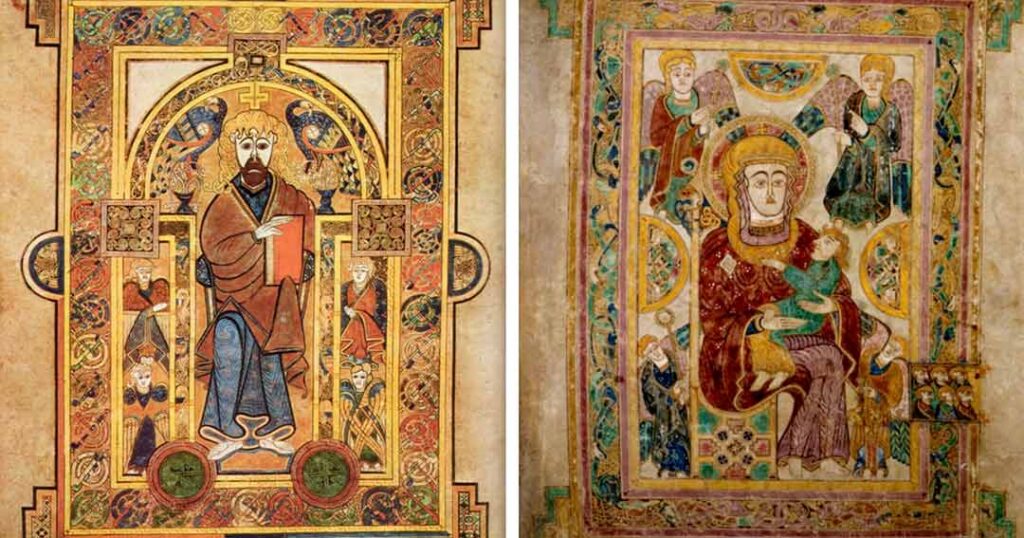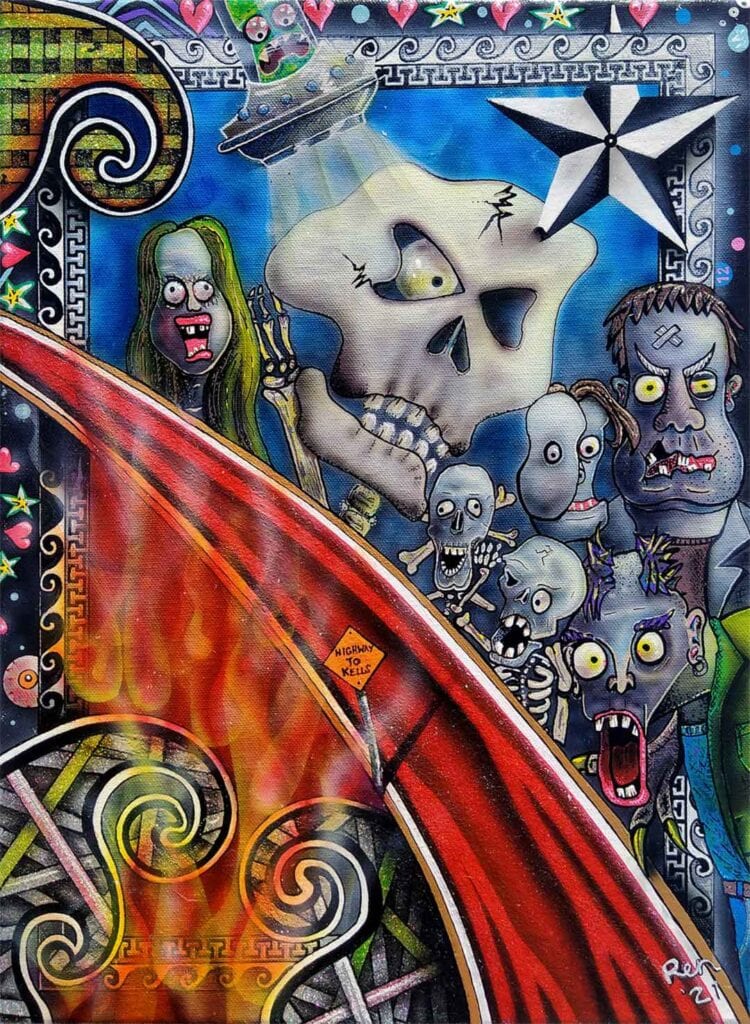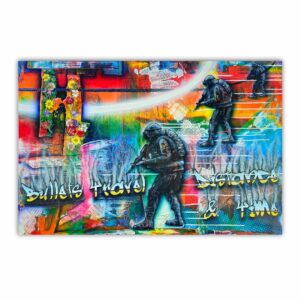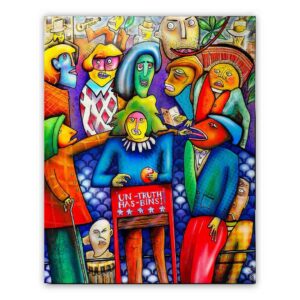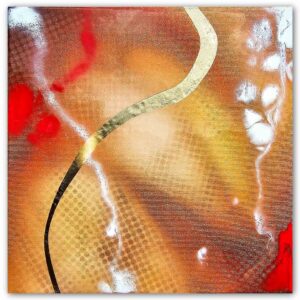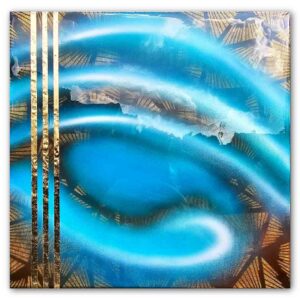- [email protected]
- +353 (0)86 224 0139
- Free Shipping Worldwide
Cultural Identity & Famous Irish Art
From early illuminated manuscripts from the Middle Ages to contemporary styles from today's art scene, Ireland has a wealth of art. This article will introduce you to a few of Ireland's most well-known and lesser-known artists, as well as the cultural significance of their work.
Reading Time: 20 minutes
TL;DR
- Discover the rich cultural heritage of Ireland through its famous art: Explore the works of celebrated Irish artists from the Middle Ages to modern times, and learn about the cultural significance of their pieces.
- Uncover hidden gems from Ireland’s art scene: Get introduced to lesser-known Irish artists and their innovative styles, and find out what makes their work unique and worth your attention.
- Dive into the stories behind Ireland’s most iconic art pieces: Understand the historical context, inspiration, and meaning behind some of Ireland’s most famous artworks, and how they reflect the country’s cultural identity.
Introduction: Exploring the Rich Tapestry of Irish Art and Culture
Step into the enchanting world of Irish art and culture, where mythical creatures and legendary figures come to life in vibrant hues and captivating designs. From the ancient Celtic traditions to the modern-day masterpieces, the story of Irish art is a tapestry woven with threads of history, folklore, and creative expression.
In this article, we’ll embark on a journey to explore the cultural identity of the Irish people through their famous art and discover how their artistic heritage has been shaped by their unique history, myths, and traditions.
The Vibrant History of Irish Art
Irish art history is a rich and varied tapestry, with a long and proud tradition that has seen the country produce some of the world’s most celebrated artists. Spanning from the early illuminated manuscripts of the Middle Ages to the European styles of the contemporary art scene, the history of Irish art is a testament to the country’s creative spirit and innovative vision.
The island of Ireland is home to a wealth of artistic treasures, and its artists have often pushed the boundaries of what is possible. From the intricate designs of Celtic art to the modernist masterpieces of the 20th century, Irish art has always been characterized by its unique blend of tradition and innovation.
Throughout the centuries, Irish artists have drawn inspiration from their surroundings, using the country’s rugged landscapes, vibrant culture, and rich history as a source of creative fuel. From the mystical landscapes of the Irish countryside to the bustling streets of Dublin, the island has been a constant source of inspiration for generations of artists.
Today, Irish art continues to thrive, with a new generation of artists pushing the boundaries of what is possible. From traditional mediums like painting and sculpture to more contemporary forms like photography and digital art, the contemporary art scene in Ireland is alive and well, offering a glimpse into the country’s rich artistic heritage and its continued commitment to creative expression.
Mythology and Legends: A Dreamy Inspiration for Irish Art
Irish mythology and legends have long been a source of inspiration for the country’s artists, shaping the cultural context of famous Irish art. Delving into these mythological figures and stories can enrich our understanding of the complex and unique history of Irish culture, influenced by the Vikings, Finns, Normans, Germans, Danes, and Anglo-Saxons.
Ireland’s history is a tapestry of myth, legend, and fine art, with themes depicted in modern art that are often lively, full of action, and detail. From the mystical landscapes of the Irish countryside to the epic tales of Celtic heroes, the island’s rich cultural heritage has been a constant source of creative fuel for generations of Irish artists.
By exploring the mythological roots of Irish art, readers can gain a deeper appreciation for the cultural context that has shaped some of the world’s most celebrated art. Whether it’s the legendary exploits of Cú Chulainn, the mystical powers of the Sidhe, or the magical landscapes of the Otherworld, the mythology of Ireland has been a constant source of inspiration for artists throughout the ages.
In Celtic mythology, the Otherworld is considered to be the realm of the deities and, possibly, the dead. In Gaelic and Brittonic myth, it is often described as a supernatural realm of eternal youth, beauty, health, abundance, and joy.
Celtic Art: Intricate Expressions from Ancient Origins
Celtic art has fascinated people for centuries with its intricate beauty. Its origins can be traced back to the ancient Celtic tribes, who inhabited parts of Europe from 1200 BCE to 400 CE.
The Celts held a deep appreciation for art and craftsmanship, showcasing their rich cultural heritage. Their artwork featured intricate patterns, spirals, knots, and zoomorphic designs. These motifs adorned metalwork, stone carvings, pottery, and illuminated manuscripts.
Celtic art emerged from a blend of influences. The Celts found inspiration in their natural surroundings, incorporating elements of nature into their designs. They also integrated motifs from other cultures they encountered through trade or conquest.
The La Tène culture, which emerged in Central Europe during the late Iron Age (from about 450 BC to the Roman conquest in the 1st century BC), played a significant role in shaping Celtic art. The La Tène style introduced new artistic techniques and motifs that greatly influenced Celtic artwork.
Celtic art’s origins are deeply connected to spiritual beliefs and symbolism. Many designs held religious or symbolic meanings for the Celts, representing concepts like fertility, protection, or the interconnectedness of life.
The Timeless Allure of Irish Literature
Irish literature is one of the most celebrated in the world, rich in poetic mythology and anachronisms. From the works of George Bernard Shaw, William Butler Yeats, and James Joyce to Oscar Wilde, Ireland has given us some of the world’s most famous authors
Irish literature has a timeless allure with its unique blend of myth, legend, and historical events that have shaped the country’s cultural heritage. The works of these renowned authors continue to captivate readers with their masterful storytelling, vivid imagery, and deep exploration of the human condition
Whether it’s the mythical landscapes of Celtic Ireland, the political and social upheavals of the 19th and 20th centuries, or the everyday lives of ordinary people, Irish literature has always been a reflection of the country’s complex and ever-changing identity. Through their works, these authors have left an indelible mark on the literary world, and their legacy continues to inspire new generations of writers and readers alike.
Niall of the Nine Hostages: A Legendary High King of Ireland
Niall of the Nine Hostages, also known as Niall Noígíallach, was a legendary High King of Ireland who ruled during the 5th century. His reign was marked by political alliances, territorial expansion, and cultural exchange, solidifying his place as one of the most prominent figures in ancient Ireland.
The Name “Nine Hostages”
The title “Nine Hostages” refers to Niall’s practice of taking hostages from rival kingdoms as a means of securing alliances and maintaining control over his vast territory. This strategic move not only solidified his power but also established him as a formidable leader within the region.
Historical Records and Descendants
While much of Niall’s life remains shrouded in legend and folklore, historical records attest to his influence and achievements. His descendants would go on to become some of the most powerful dynasties in Ireland, including the Uí Néill (O’Neill) clan.
Legacy and Identity
Today, Niall of the Nine Hostages stands as an emblematic figure in Irish history, symbolising leadership, strategic prowess, and enduring legacy. His story serves as a reminder of the rich tapestry that weaves together Ireland’s past and continues to shape its present identity.
Themes in Irish Art: Reflecting History, Culture, and Beauty
Some of the many themes in Irish art reflect the country’s captivating history, culture, and natural splendor. From landscapes to mythology, Irish artists have explored these themes for centuries, creating a unique and captivating body of work.
One prominent theme is the depiction of Ireland’s stunning landscapes. Artists capture the beauty of rolling green hills, rugged coastlines, and picturesque countryside on canvas. Through brushstrokes, they convey both the physical features and spiritual essence of the land. Jack B. Yeats, known for his lush landscapes of County Sligo, is a renowned example.
Mythology and folklore also inspire Irish artists. With a rich tradition of storytelling, Ireland’s cultural fabric weaves ancient gods and mythical creatures together. Artists draw from these legends, creating evocative and symbolic artworks exploring heroism, love, tragedy, and transformation.
Irish art also reflects the struggle for independence and political turmoil. Artists use their work to comment on social issues and convey national identity. Powerfully using imagery and symbolism, they explore themes of oppression, resistance, resilience, and hope.
Religion has significantly influenced Irish art. Christianity’s impact is evident in paintings, sculptures, stained glass windows, and other forms of artistic representation.
Contemporary Irish art embraces global themes like globalisation, urbanisation, gender equality, and environmental concerns. Artists address these pressing issues while staying rooted in their cultural heritage, using various mediums to express their perspectives.
Religion’s Enduring Influence on Irish Art
Irish art has a rich and storied history, with religious beliefs and traditions playing a significant role in shaping its unique style and aesthetic. From the intricate Celtic crosses and Celtic knotwork that adorn ancient monasteries to the stunning stained glass windows that illuminate modern churches, the influence of religion on Irish art is unmistakable.
For centuries, Irish artists have drawn inspiration from their faith, using it as a source of creative expression and a means of exploring the human condition. The intricate designs and patterns found in Celtic art, for example, are often said to represent the interconnectedness of all things and the sacred nature of the natural world.
In addition to its aesthetic influence, religion has also played a role in shaping the subject matter of Irish art. Many works of Irish art depict religious figures and scenes, such as the Virgin Mary, saints, and biblical prophets. These depictions not only reflect the religious beliefs of the artists but also serve as a means of storytelling and cultural preservation.
Today, the influence of religion on Irish art can still be seen in the works of contemporary artists, many of whom continue to draw inspiration from their faith and the rich religious heritage of the island. Whether it’s through the use of sacred symbols, the exploration of spiritual themes, or the preservation of religious traditions, the role of religion in Irish art remains a vital and enduring aspect of the country’s cultural identity.
The Book of Kells: An Irish Masterpiece
The Book of Kells is a renowned illuminated manuscript that dates back to the 9th century, housed in Trinity College Dublin, Ireland. This exquisite work of art is a Gospel book in Latin, containing the four Gospels of the New Testament, and is considered one of Ireland’s most precious cultural treasures.
Celtic monks created the Book of Kells around the year 800 AD, with some scholars believing it was originally produced in a monastery on the island of Iona off the coast of Scotland. However, when Vikings attacked Iona, the surviving monks fled to a sister monastery in Kells, Co. Meath, where the book was possibly finished.
The Book of Kells is a testament to the artistic skill and devotion of the Celtic monks who created it. The book features lavish decorations and illustrations, including a famous portrait of the author, Saint Matthew. It is believed that three artists and four scribes worked on the book, with each page taking up to two months to complete.
The book’s intricate designs and illustrations are a blend of Celtic and Christian motifs, showcasing the unique artistic style of the time. The pages are adorned with intricate patterns, including Celtic knots, which are said to represent the interconnectedness of all things.
The Book of Kells is not only a masterpiece of Irish art but also a window into the country’s rich history and cultural heritage. It is a testament to the enduring power of faith and creativity, and a reminder of the important role that art and culture have played in shaping Ireland’s identity.
Today, the Book of Kells is considered one of Ireland’s most prized possessions, and it continues to inspire and captivate visitors from around the world. Its beauty and historical significance make it an essential part of Ireland’s cultural legacy, and a must-see for anyone interested in art, history, or religion.
The Secret of Kells
Based on the origins of Ireland’s most famous illustrated manuscript, The Secret of Kells is a 2009 Irish-French-Belgian animated fantasy film about the making of the Book of Kells.
The film was created by award-winning Irish animation studio Cartoon Saloon, based in Kilkenny.
Brehon Law: A Progressive Legal System of Ancient Ireland
Brehon law, also known as Early Irish law, offers a unique glimpse into the legal system of pre-English rule Ireland. This ancient legal code recognised and protected women’s rights, emphasized fairness and justice for all, and encouraged peaceful resolution of disputes.
- Women’s Rights in Brehon Law: Brehon law was ahead of its time in recognizing and protecting women’s rights. Women could inherit property, own land, and engage in business transactions. They could also serve as judges and mediators in legal disputes. This progressive approach to women’s rights is a testament to the value placed on gender equality in early Irish society.
- Fairness and Justice in Brehon Law: Brehon law emphasized fairness and justice for all members of society. It encouraged the use of mediation and negotiation to resolve disputes, rather than resorting to violence or punishment. This approach helped maintain social harmony and promote community cohesion.
- Early Irish Society and Brehon Law: Brehon law provides valuable insights into early Irish society and its cultural heritage. The law was based on a complex system of social hierarchy and kinship ties, reflecting the values and beliefs of the time.
- Influence of Christianity on Brehon Law: Brehon law was influenced by Christianity, which was introduced to Ireland in the 5th century. The law incorporated Christian principles, such as the importance of forgiveness and the value of charity, into its legal code.
- English Influence on Brehon Law: English rule in Ireland, which began in the 12th century, had a significant impact on Brehon law. Many of the traditional Brehon laws were replaced or modified to conform to English law.
- Modern Relevance of Brehon Law: The emphasis on fairness, equality, and peaceful resolution in Brehon law can provide valuable lessons for modern society. The law’s focus on community cohesion and the importance of forgiveness and charity are also relevant today. Studying Brehon law can inspire us to strive for a more just society.
By exploring the intricacies of Brehon law, we gain a deeper understanding of how early Irish society functioned and how it valued the rights and contributions of women. It serves as a testament to the rich cultural heritage that predates English influence in Ireland.
Studying Brehon law not only sheds light on an often overlooked aspect of legal history but also provides valuable lessons that can be applied in modern times. Its emphasis on fairness, equality, and peaceful resolution can inspire us today as we strive for a more just society.
The Role of Women in Irish Art: A Story of Resilience and Creativity
The role of women in Irish art has been a topic of great significance, with female artists making invaluable contributions to the country’s vibrant and diverse art scene. Despite facing challenges, women have played a pivotal role in shaping the artistic landscape of Ireland, bringing forth powerful narratives that reflect the rich cultural heritage of the country.
Female artists in Ireland have excelled in traditional mediums like painting and sculpture while also embracing innovative forms of expression like installation art, performance art, and digital media. Their works explore a wide range of themes, including identity, history, social issues, and personal experiences.
While progress has been made towards gender equality within the Irish art community, there is still work to be done. Female artists continue to face obstacles such as limited representation in galleries and museums, unequal opportunities for exhibitions and funding, and societal expectations that can hinder their artistic pursuits.
However, there are efforts underway to address these challenges. Initiatives promoting gender equality in the arts are gaining momentum, with increased support for female artists through grants, residencies, mentorship programs, and dedicated platforms for showcasing their work.
The role of women in Irish art is not just about individual achievements but also about creating an inclusive space where diverse voices can be heard. By celebrating their contributions and advocating for equal opportunities within the industry, we can ensure that future generations of female artists continue to thrive and make significant contributions to Irish art.
Key Points:
- Female artists, such as Norah McGuinness and Rita Duffy have made significant contributions to the country’s art scene.
- Despite challenges, women have played a pivotal role in shaping the artistic landscape of Ireland.
- Initiatives promoting gender equality in the arts are gaining momentum.
- The role of women in Irish art is not just about individual achievements but also about creating an inclusive space for diverse voices.
- By celebrating their contributions and advocating for equal opportunities, we can ensure that future generations of female artists continue to thrive.
Irish Folk Art: A Cherished Aspect of Ireland’s Cultural Heritage
Irish folk art is a vibrant and meaningful expression of Ireland’s cultural heritage, encompassing a wide range of traditional crafts that showcase the country’s rich artistic legacy. From intricate woodcarvings to delicate lacework, this art form is a testament to the craftsmanship and creativity of its artisans, and each piece tells a story that reflects the values and traditions of the Irish people.
Symbolism and Craftsmanship
Irish folk art is characterized by its deep symbolism, with each piece drawing inspiration from nature, mythology, and religious beliefs. The intricate patterns and motifs found in Irish folk art are not merely decorative; they carry profound meaning and reflect the essence of Ireland’s cultural identity. The craftsmanship involved in creating these pieces is truly remarkable, with skilled artisans dedicating countless hours to produce exquisite works of art that capture the spirit of Ireland.
Forms of Decorative Arts
Irish folk art encompasses various forms of decorative arts, including pottery, metalwork, embroidery, and painting. These art forms not only serve as expressions of creativity but also as functional objects that enhance everyday life. From beautifully painted ceramics to intricately embroidered textiles, each piece reflects the unique style and artistic flair associated with Irish folk art.
Preserving Cultural Heritage
Irish folk art stands as a testament to Ireland’s rich cultural heritage, and its traditional crafts embody centuries-old traditions while showcasing exceptional craftsmanship and symbolic storytelling. By preserving this art form, we ensure that future generations can appreciate the beauty and significance of Irish folk art for years to come.
The Impact of Colonization on Irish Art: A Legacy of Resistance and Fusion
The colonization of Ireland by England has had a profound impact on the country’s art, shaping its development and expression in complex and multifaceted ways. From the suppression of Irish artistic identity to the fusion of traditional and contemporary styles, the legacy of colonization can be seen in the themes, mediums, and techniques used by Irish artists.
Resistance and Autonomy
During periods of English rule, Irish artists faced significant challenges in expressing their cultural identity through their work. The dominant English influence sought to suppress and control Irish artistic expression, leading to a struggle for autonomy and preservation of Irish heritage and culture. Despite these challenges, Irish artists found ways to resist and assert their unique identity through their art.
Through painting, literature, music, and theatre, Irish artists conveyed their experiences under colonization and expressed their longing for independence. They drew inspiration from Ireland’s complex history, mythology, and folklore, using these themes to assert their cultural identity and resist the dominant English influence.
Fusion of Styles
Colonization also brought about a fusion of artistic styles as Irish artists were exposed to different techniques and influences from the colonizers. This cross-pollination resulted in a rich blend of traditional Irish elements with contemporary European styles. Irish artists incorporated new techniques and mediums into their work, while still maintaining their unique cultural identity.
Today, we can see the lasting impact of colonization on Irish art through themes that explore national identity, political struggles, folklore, and cultural heritage. Artists continue to draw inspiration from Ireland’s complex history while incorporating modern perspectives, creating a vibrant and diverse artistic landscape.
Irish Art: Preserving Historical Records and Tracing Descendants
Irish art has a rich and storied history, with its roots deeply ingrained in the cultural heritage of Ireland. From ancient Celtic designs to contemporary masterpieces, Irish artists have made significant contributions to the world of art. However, preserving the historical records and tracing the descendants of these talented artists can be challenging tasks.
The fire at the Four Courts in 1922 resulted in the loss of many valuable documents and records pertaining to Irish art heritage. This loss has made it difficult to piece together the complete history of Irish art and the artists who created it. Despite this setback, historians and researchers have been working tirelessly to reconstruct the lineage of Irish artists and uncover hidden stories.
By delving into archives, conducting extensive research, and collaborating with experts, historians are working to reconstruct the lineage of Irish artists. This not only helps shed light on their artistic journey but also provides valuable insights into Ireland’s cultural heritage.
Tracing descendants is another crucial aspect of understanding the legacy left behind by these talented individuals. By connecting with living relatives and descendants, we can gain a deeper understanding of their lives, inspirations, and contributions to Irish art. This not only helps to preserve the historical record but also ensures that the artistic achievements of these individuals are not forgotten.
Preserving historical records and tracing descendants is not just about documenting names and dates; it is about celebrating the artistic achievements that have shaped Ireland’s cultural identity. It allows us to appreciate their work on a more personal level while ensuring that future generations continue to cherish this invaluable artistic heritage.
Irish Travellers: A Unique Culture
Irish Travellers, with their rich and distinctive culture, have captivated the world with their unique way of life. Rooted in centuries-old traditions, these nomadic communities have managed to preserve their heritage despite facing discrimination and challenges.
The Irish Travellers’ nomadic lifestyle sets them apart from mainstream society. Their caravans and encampments serve as a symbol of their freedom and connection to the open road. This wandering existence allows them to maintain a close-knit community, where traditions are passed down through generations.
Despite facing prejudice and stereotypes, Irish Travellers have remained resilient in preserving their cultural identity. Their vibrant music, storytelling, and craftsmanship reflect a deep sense of pride in their heritage. From traditional horse fairs to lively weddings, every aspect of their culture is steeped in history and symbolism.
However, it is important to address the discrimination that Irish Travellers continue to face. Stereotypes perpetuated by media portrayals often overshadow the richness of their culture. By raising awareness about the unique contributions they make to society, we can challenge these misconceptions and foster greater understanding.
History and Culture of Irish Travellers
In the Irish language, travellers are known as an lucht siúil, which means ‘the walking people’. Also known as Pavees, or Mincéirs (Shelta: Mincéir).
Travellers have a distinct identity and culture, based on a nomadic tradition and outdoor life, which distinguishes them from sedentary populations or ‘settled people’.
Cultural values are the deep-seated norms that shape our understanding of what is right or wrong, beautiful or ugly, admirable or worthless. There are many cultural similarities between travellers, including shared languages, customs, and unique traditions.
Clusters of Genes
Irish travellers have been a part of Irish society for centuries, with their origins shrouded in mystery.
Despite a lack of documentation, DNA analysis has revealed that the Traveller community contains four genetic clusters or subdivisions, which correspond to their social groupings and language use.
One cluster is associated with the “Rathkeale group” of Travellers, while two others are tied to whether Travellers speak the Cant or Gammon dialect of Shelta, the Traveller language.
Studies have shown that Roma* did not significantly contribute to Traveller DNA, debunking a long-held belief that the two groups were genetically related.
After years of campaigning, March 1st, 2017 was a historic day for the Irish Traveller community, as they were officially recognised as an ethnic group within the Irish State.
Important Note
For the avoidance of doubt, the politically correct term for the ethnic group commonly referred to as “Gypsies” is “Romani people” or “Roma“.
Europeans used the word “gypsy” as a racial slur throughout the centuries to justify the discrimination and persecution of the Roma people.
Travellers Outside of Ireland
In England, there are several distinct groups of travellers, including: Romany, Irish Travellers, New Age Travellers, and Circus and Fairground families.
While each group has its own unique cultural traditions and values, they share a nomadic lifestyle or heritage and face similar challenges and discrimination in their daily lives.
These groups experience high levels of prejudice and discrimination, making it difficult to maintain their way of life and heritage. Additionally, they face challenges in accessing healthcare, education, and secure housing, which has resulted in a significantly lower life expectancy compared to the national average.
Origins of Language
You may not be aware that many common words in the English language have their origins in Romany.
The Romany language, also known as Romani, is an unwritten language believed to have originated in Northern India, drawing from Hindi, Sanskrit, and Punjabi languages.
Everyday words that have their roots in Romany language include the popular name for a sweet, ‘Lollipop’, which derives from ‘loli phabai’, meaning red apple. This was a traditional Roma custom of selling candied apples on a stick.
Another example is the term ‘cushty’, which comes from the Romany word ‘kushitipen’ or ‘kushti’, meaning ‘very good’. This phrase gained popularity through David Jason’s character Derek ‘Del Boy’ Trotter in the BBC TV series Only Fools and Horses.
Traveller Culture: Crafts, Traditions, and Wanderlust
Travellers have a rich history, marked by a love of adventure and a nomadic spirit. Many travel alone, but the culture also embraces group or family travel.
Seasonal work for men range from harvesting crops, mending pots and pans and general labouring. Whereas trades for women, typically were telling fortunes, selling lucky heather and picking wild flowers to sell. Summer work would include the seasonal picking of fruit.
Community is at the core of traveller culture. Travellers enjoy meeting other travelling communities and sharing stories of their adventures. Some make a living by trading goods. There’s always space for another traveller to join the group.
The Craft of the Tinsmith: A History of Skilled Artisanship
The craft of the tinsmith has been a vital occupation for centuries, with a rich history of transforming metals into beautiful and functional items. Tinsmiths have been fabricating essential items such as tin pots, kettles, pans, lanterns, and mousetraps for generations. Unlike blacksmiths, who rely on a hearth to heat and shape their raw materials, tinsmiths work primarily with cold metal, requiring a unique set of skills and techniques
The Art of Shaping Metal
Tinsmithing is a highly specialised craft that demands a great deal of practice and patience to master. Tinsmiths must have a deep understanding of the properties of different metals and how they can be shaped and moulded to create the desired form. The process involves cutting, shaping, and joining metals using a variety of tools and techniques, such as hammering, annealing, and soldering.
The History of Tinsmithing
The history of tinsmithing can be traced back to ancient civilizations, where tin was a highly valued material for making cooking utensils, weapons, and other objects. The craft continued to evolve throughout the Middle Ages and the Industrial Revolution, with the introduction of new technologies and techniques. Today, tinsmithing is still practiced by skilled artisans around the world who continue to push the boundaries of what is possible with this versatile and beautiful material.
The Beauty of Tinsmithing
One of the most striking aspects of tinsmithing is the beauty of the finished products. Tinsmiths are able to create intricate and delicate designs, as well as sturdy and functional items, using a variety of techniques and tools. The result is a wide range of items that are not only practical but also aesthetically pleasing, making tinsmithing a highly sought-after craft.
Irish Horses: A Rich History and Culture
Horses have long been revered in Ireland, with a history dating back to ancient times. One of the most famous horses is the Byelerley Turk (c. 1680–c. 1703), also spelled Byerly Turk. He was a fighting horse in the Ottoman cavalry who was captured by the English during the Siege of Buba.
This noble animal went on to win several races and fight in the Battle of the Boyne before retiring to Yorkshire, where he became one of the founders of the modern thoroughbred horse racing bloodstock.
The Irish National Stud, established in 1906–1910 by Colonel William Hall-Walker, features beautiful Japanese gardens and is home to some of the most sought-after horses in the world.
However, the farm was left in obscurity during the Irish War of Independence and was returned to the Irish Government in 1943. The Irish National Stud Company was founded to preserve the Irish horse breed, and today, Irish horses are highly sought after in the sports of racing and show jumping.
Irish horses have long been renowned for their exceptional qualities and have made a significant impact in the equestrian world. From their strength and athleticism to their intelligence and versatility, Irish horses have captured the hearts of riders and enthusiasts worldwide.
One of the key factors that contribute to the success of Irish horses is the rich equestrian heritage and culture in Ireland. The country’s lush green landscapes, mild climate, and extensive breeding programmes have created an ideal environment for raising top-quality horses.
Irish horses excel in various disciplines, including show jumping, eventing, dressage, and racing. Their natural agility and boldness make them well-suited for jumping courses with ease, while their endurance allows them to perform exceptionally well in cross-country events. Additionally, Irish-bred racehorses have achieved remarkable success on prestigious tracks around the globe.
The versatility of Irish horses is another notable attribute. They are known for their adaptability across different disciplines, making them suitable for both amateur riders seeking a reliable companion as well as professional athletes aiming for top-level competition.
Furthermore, Irish horse breeders prioritise producing animals with excellent temperaments along with physical attributes. This emphasis on temperament ensures that Irish horses are not only talented but also possess a willing nature that makes them trainable and enjoyable to work with.
In the past, every young man was expected to learn how to ride, as horses were not only a mode of transportation but also an essential aid to farming, such as with ploughing. However, with the rise of mechanisation, horses are no longer as widely used for work purposes. Despite this, the equestrian industry remains a significant employer, with riding schools, trail riding, and hunting being popular activities.
Hunting with hounds is a longstanding tradition in Ireland, dating back to ancient times and featured in Celtic literature and legend.
Horses and Horse Traders in Ireland
Horses have been an integral part of Irish culture for centuries, and horse traders play a crucial role in connecting buyers and sellers. These middlemen can specialize in specific types of horses, such as racehorses, ponies, workhorses, or donkeys.
In the past, horse-trading was a significant aspect of everyday life in Ireland. To acquire a high-quality horse, traders would participate in races, and the winner would get to keep the horse. This process was time-consuming, but it allowed traders to select the best horses for their clients.
The horse has become a symbol of strength and power in modern Ireland, and many artists have celebrated this iconic animal in their works. For instance, Jack Butler Yeats’ “In The Whistle of a Jacket” (1946) features high impasto paintwork; (exuberantly applied paint), that emphasizes the theme of unmitigated freedom. Painting horses was an emotional release for Yeats, and his works continue to be celebrated today.
There are various types of horses in Ireland, including trotters and saddle horses. Trotters are bred for speed, while saddle horses are built for riding. Whether you’re looking for a fast trotter or a sturdy saddle horse, there’s sure to be a horse trader in Ireland who can help you find the perfect equine companion.
Smithfield Horse Market, Dublin: A Contentious History and Uncertain Future
For over 400 years, the Smithfield Horse Market in Dublin has been a hub of horse trading and a monthly event that brings together buyers and sellers from all over the country.
However, in recent years, the market has been the subject of controversy and criticism, leading to a by-law passed in 2013 that reduced the frequency of the fair to twice a year and established new rules and regulations.
The main reasons for the change were violent incidents and complaints from nearby residents who objected to the noise, atmosphere, and perceived animal abuse and neglect.
Despite its long history, the Smithfield Horse Fair continues to face criticism from various sources, including the Garda Síochána (Irish Police) and the Dublin Society for Prevention of Cruelty to Animals (DSPCA).
Efforts to close down or relocate the market have been met with legal challenges and opposition from those who wish to preserve its heritage. Dublin City Council and the market’s defenders are embroiled in an ongoing battle, with no clear resolution in sight.
The future of the Smithfield Horse Market remains uncertain as it grapples with the challenges of balancing its historical significance with the needs and concerns of the modern community.
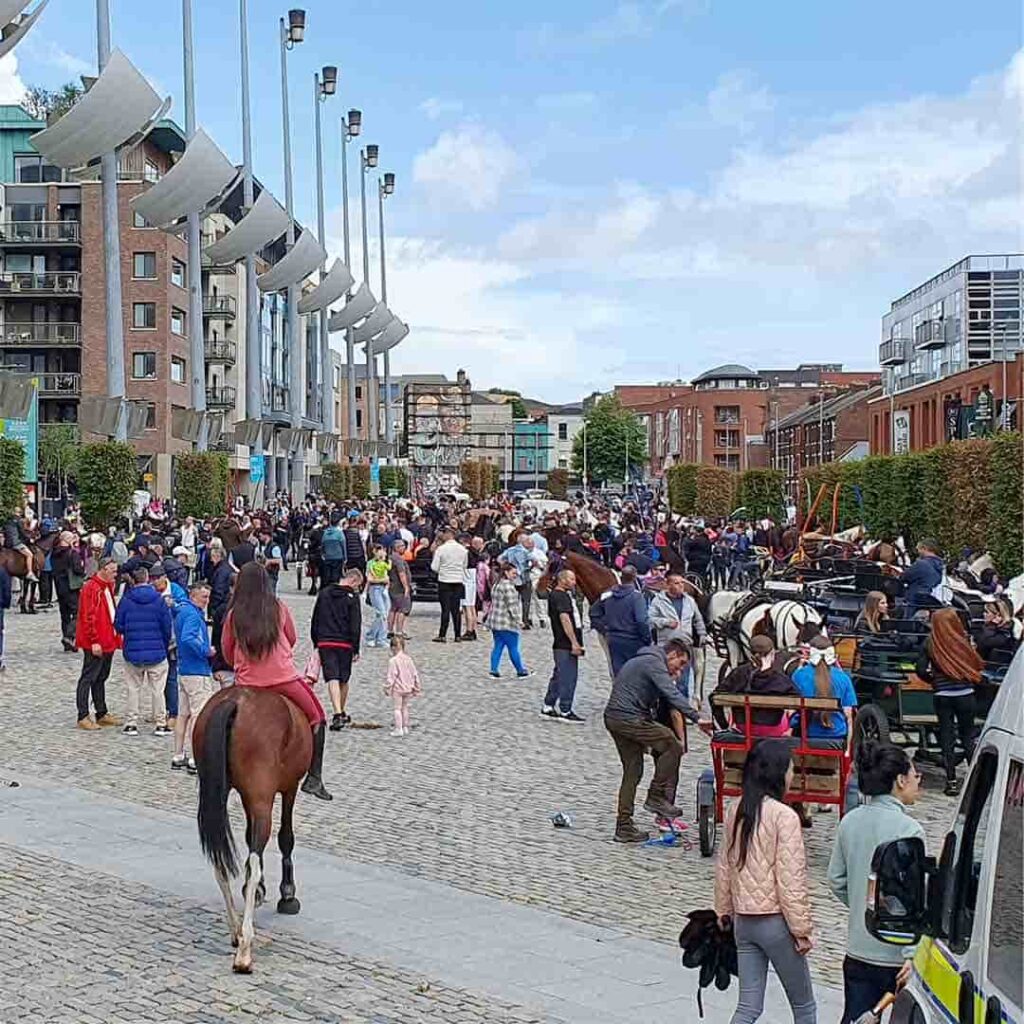
Ballinasloe International October Fair: A Traditional Event with a Modern Twist
The Ballinasloe International October Fair & Festival, held in Ballinasloe, Co. Galway, is a three-day event that has been a cornerstone of Irish tradition for centuries. Established during the time of the High Kings of Tara, this fair has been an annual gathering point for horse dealers, musicians, and revellers alike. Today, the fair continues to thrive, blending traditional practices with modern attractions.
At the heart of the fair is the sale of horses, with hundreds of dealers gathered on the Fair Green, negotiating deals the old-fashioned way—no auctioneers or fancy sales rings here! The spit swear, a bond between two people who have just come to some sort of agreement, is still a common practice, adding a unique and memorable touch to the proceedings.
But the fair offers much more than just horse trading. Music, particularly traditional music, is everywhere, with tug-of-war competitions, bareback riding, and a carnival providing plenty of entertainment for all ages. Street traders selling everything from traditional crafts to modern gadgets add to the festive atmosphere.
Whether you’re a horse enthusiast, a music lover, or simply looking for a unique cultural experience, the Ballinasloe International October Fair has something for everyone. So why not plan a visit and experience this special event for yourself?
Caravan Painting: A Rich History
In the early days of travelling, families would place their belongings on open carts and live in tents called Bender tents. However, by the 1880s, these flat carts had evolved into wooden wagons called Vardos, which were pulled by horses. Inside these waggons, families would have a double bed and, underneath that, a single bed for the youngest child. The other children would sleep outside under tarpaulins.
Unique and Personal Designs
Hand-painted Romany bowtop caravans are decorated with personal and unique designs that reflect the countryside they travel through. Each design is special to that family and often features family horses, birds, flowers, fruit, and animals. Some families even incorporate designs from Ancient Rome, such as grapes, lions, classical lines, and scrolls.
The Richness of Decoration
The status of a traveller family could be determined by the intricacy of the designs on their Vardo. The more elaborate the decoration, the wealthier the family. This tradition can still be seen today in the elaborately decorated grave plots and memorials of ancestors past.
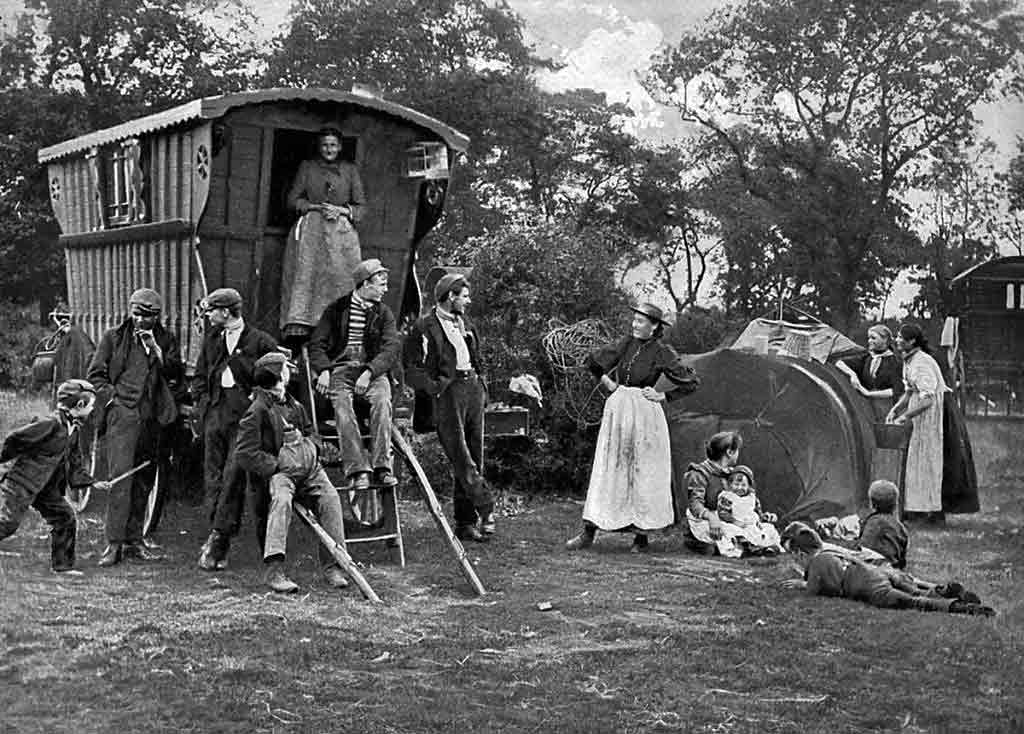
Canal Barges
Narrowboats, designed for narrow locks, were a vital part of Britain’s canal network during the Industrial Revolution. The Grand Canal and Royal Canal were built to compete with each other, providing a nationwide transport network. However, with the rise of railways, commercial traffic declined, and by the 1970s, long-distance transportation of goods had almost disappeared.
Roses and Castles: A Colourful Tradition
To decorate their working narrowboats, canal boat owners and operators used a unique and colourful style of folk art called Roses and Castles. This decorative style likely originated in the Birmingham and Black Country areas of England, with influences from Romani people and various forms of furniture.
Similarities with Traveller Culture and Folk Art
Historians have noted similarities between the Roses & Castles style and traveller culture, as well as folk art from Germany, Holland, and Asia. The exact origin of the style is unknown, but its popularity and growth can be attributed to the limited space on narrowboats, the pride of the boat people, and the competition between the canals and railways.
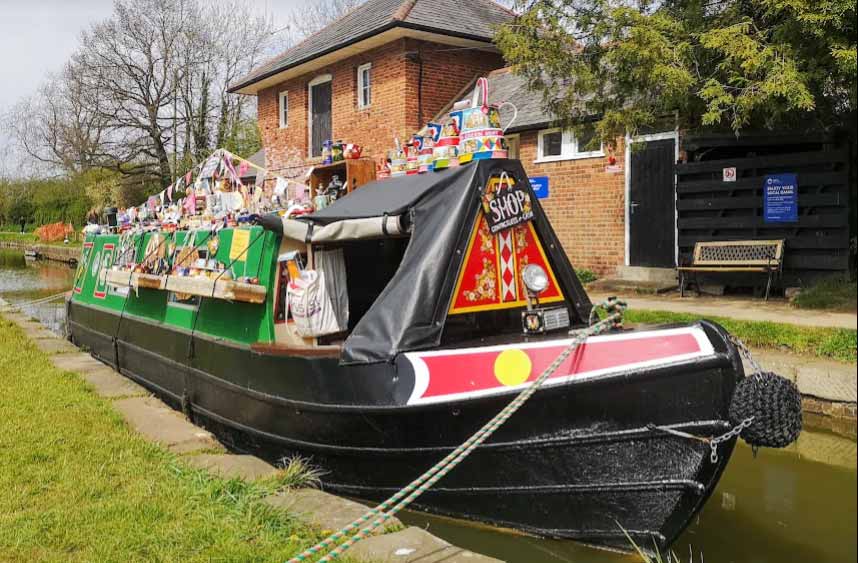
Traveling Circus and Amusements
Duffy’s Circus, one of the oldest in the world, has been entertaining audiences in Ireland for over three centuries. Founded in the 18th century, the circus has visited each county in Ireland annually.
Traveling Amusements: A Family Tradition
While not technically Irish, I have fond memories of attending the Stanley Thurston & Sons Family Fun Fair in Wardown Park, Luton. The fair featured hand-painted rides and decorative elements, including Roses and Castles style artwork.
Stanley Thurston, born in 1898, was a well-known showman in the east of England. He grew up surrounded by fairgrounds and learned the trade before inheriting several old attractions from his father. The early 1930s saw the introduction of modern lightweight machines like the dodgems, which were passed down to the next generation.
Commonalities of Traveling Lifestyles
Both Duffy’s Circus and Stanley Thurston & Sons Family Fun Fair represent a unique and colorful aspect of traveling entertainment. The ornamentation and decorative elements used in these circuses and fairs reflect the pride and craftsmanship of the performers and operators.
Exploring the Legacy of Famous Irish Artists
Ireland boasts a vibrant artistic history, with talented individuals leaving their mark on the creative world. From painters to sculptors, Irish artists have showcased their unique perspectives and captured the essence of Irish culture.
Renowned names like Jack B. Yeats, Sean Scully, and Harry Clarke have made profound contributions. Jack B. Yeats’s captivating paintings, Sean Scully’s abstract creations, and Harry Clarke’s intricate stained glass windows are just a glimpse into the immense talent that hails from Ireland.
Yet, Ireland’s artistic legacy doesn’t end there. Contemporary artists continue to thrive, drawing inspiration from the country’s strong cultural identity. From traditional landscapes to modern abstracts, Irish artists push boundaries and explore new artistic territories.
While these famous artists have left an indelible mark, it’s important to remember that countless other talented Irish artists have made significant contributions to the art world. Beautiful artworks and sculptures by well-known and lesser-known artists can be found throughout Ireland.
So, the next time you encounter a piece of Irish art, take a moment to appreciate the skill, passion, and unique perspective that went into creating it. Ireland’s artistic heritage is a testament to the country’s rich cultural identity and serves as an endless source of inspiration.
So let us look at a few of these well-known Irish artists.

Charles Jervas (1675-1739): A Multifaceted Artistic Genius
Charles Jervas, an Irish painter, art critic, and translator, left an indelible mark on the art world during his time. Born in Dublin, Jervas’s passion for painting and his exceptional talent propelled him to become one of the most sought-after portrait artists of his era. His artistic journey took him from Dublin to London, where he established himself as a prominent figure in the art scene.
Masterful Portraits and Painstaking Attention to Detail
Jervas’s skillful brushwork and attention to detail earned him recognition and patronage from influential individuals, including members of the British aristocracy. His captivating portraits capture the essence of his subjects with remarkable precision, showcasing his mastery of the craft.
Art Criticism and Translations: A Multifaceted Talent
Beyond his prowess as a painter, Jervas made significant contributions as an art critic. His keen eye for aesthetics and understanding of artistic techniques allowed him to provide insightful commentary on contemporary works of art. His critical writings not only influenced the perception of art during his time but also continue to shape our understanding today.
Jervas was also a talented translator, translating several notable works from French into English, including Miguel de Cervantes’ “Don Quixote.” His translations were highly regarded for their accuracy and literary merit.
Legacy and Influence
Charles Jervas’s legacy lives on through his captivating portraits that capture the essence of his subjects with remarkable precision. As both an artist and a critic, he played a significant role in shaping the artistic landscape of his era. His translations further demonstrate his versatility and intellectual prowess as a multifaceted individual who left an enduring impact on the world of art and literature.
Daniel MacDonald (1821-1853): Capturing Ireland’s Famine
Irish painter Daniel MacDonald left an indelible mark on the art world with his powerful depictions of Ireland during the devastating famine. Through works like ‘The Eviction’ and ‘An Irish Peasant Family Discovering the Blight of their Store’, MacDonald portrayed the harsh realities endured by the Irish people during this tumultuous period.
Dramatic Scenes of Struggle: MacDonald’s Style
MacDonald’s style, characterised by dramatic historical genre painting, skillfully depicted scenes of struggle and despair. His vivid colors and meticulous attention to detail brought to life the stories of those affected by the famine. In one poignant painting, MacDonald captures a family’s anguish upon discovering their blighted potato stock. Their faces reveal a mix of shock and sorrow as they confront their grim reality.
Versatility and Insight: MacDonald’s Sketched Realities
Beyond his larger works, MacDonald showcased his talent and versatility through sketches and illustrations. These pieces offered glimpses into everyday life in Ireland during that period, capturing both hardship and resilience.
A Lasting Impact: MacDonald’s Legacy
Daniel MacDonald’s contributions to Irish art are profound. His ability to convey the emotions and struggles of the Irish people during the famine continues to resonate with audiences today. His work transcends aesthetics; it serves as a reminder of the hardships endured by past generations and the resilience that defines Ireland’s history.
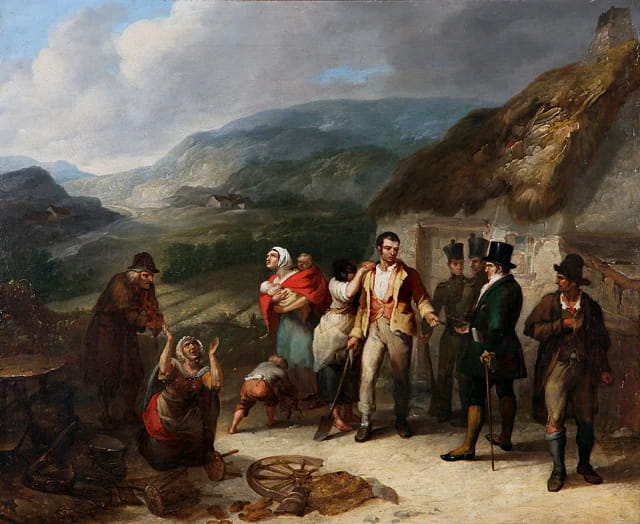
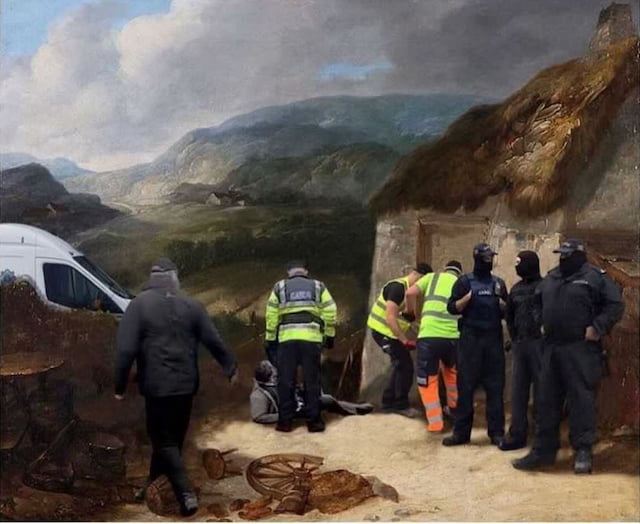
Reimagining ‘The Eviction’: Spicebag’s Political Art
Adam Doyle, known as ‘Spicebag’, is a politically motivated artist who gained recognition for his thought-provoking reinterpretation of Daniel MacDonald’s iconic painting, ‘The Eviction’. Doyle sheds light on the ongoing housing crisis in Ireland and the challenges faced by individuals and families.
From Famine to Housing Crisis: Doyle’s Artistry
Drawing inspiration from MacDonald’s original piece, which depicted a forced eviction during the Great Famine, Doyle highlights the modern-day issue of housing insecurity. Through his art, he captures the desperation and injustice experienced by those affected by evictions in contemporary Ireland.
Confronting Harsh Realities: Doyle’s Powerful Message
Doyle’s reimagining of ‘The Eviction’ serves as a powerful symbol of social and economic challenges in Irish society today. By incorporating elements like law enforcement presence and symbolic imagery representing the housing crisis, he compels viewers to confront the harsh realities within their communities.
Art as Catalyst: Doyle’s Call to Action
As a politically motivated artist, Adam Doyle uses his talent to spark conversations and raise awareness about pressing issues. His reinterpretation of ‘The Eviction’ pays homage to Daniel MacDonald’s original work while urging society to address and find solutions to the ongoing housing crisis in Ireland.
A Modern Twist: ‘Spicebag’ and the Issue at Hand
Incorporating the term ‘Spicebag’, a popular fast food dish in Ireland, Doyle cleverly draws attention to the issue in a way that resonates with modern audiences. His art serves as a powerful reminder of the need for action and change.

Harry Clarke (1889-1931): The Ethereal Beauty of Stained Glass Artwork
Harry Clarke, born in Dublin, Ireland, in 1889, is widely recognised as one of Ireland’s most prominent symbolist artists and stained glass window artisans. His artistic creation often depicted scenes from Irish mythology, folklore, literature and Celtic motifs showcasing his exceptional craftsmanship and attention to detail. To this day they continue to captivate audiences and evoke an ethereal and otherworldly atmosphere. Notably, Clarke’s work can be found in iconic locations such as St. Patrick’s Cathedral in Dublin and the renowned Bewley’s Cafe on Grafton Street.
St. Patrick’s Cathedral and Clarke’s Artistry
St. Patrick’s Cathedral in Dublin stands as a testament to the timeless beauty of Harry Clarke’s stained glass artwork. Within the cathedral, visitors are greeted by awe-inspiring windows that showcase Clarke’s mastery of the craft. These windows, adorned with delicate Celtic motifs, transport viewers into a world of enchantment and spiritual contemplation.
Bewley’s Cafe and the Classical Orders
One can also experience the mesmerising allure of Clarke’s stained glass at Bewley’s Cafe, an institution in Dublin known for its rich history and warm ambiance. Nestled on Grafton Street, this iconic establishment features six windows that beautifully depict the classical orders of Greek architecture: Doric, Corinthian, Ionic, and later Roman architecture. Each column is intricately decorated with vases of vibrant flowers, adding a touch of elegance and vibrancy to the space. In addition, two other decorative glassworks were added to a second wall in a commission by the original Bewley-family owner in 1927.
The Ongoing Controversy
Unfortunately, the pandemic and subsequent lockdowns have brought about unforeseen challenges, including a dispute over the ownership of the stained glass windows at Bewley’s Cafe. The dispute arises from the issue of rent payments owed by the tenants. While the legal matters surrounding the windows are being addressed, it is essential to acknowledge the cultural significance and artistic excellence they represent.
Harry Clarke’s contribution to the world of stained glass artwork is immeasurable. His ability to blend Celtic motifs with intricate designs has left an indelible mark on Ireland’s artistic heritage. Whether it’s the ethereal windows at St. Patrick’s Cathedral or the classical-inspired columns at Bewley’s Cafe, Clarke’s creations continue to inspire and captivate art enthusiasts from around the world. As the ownership dispute unfolds, let us not forget the enduring beauty and cultural significance of these stained glass masterpieces.

William Percy French (1854-1920): A Multi-Talented Irish Icon
Born in County Roscommon, Ireland, William Percy French (1854-1920) is a revered figure in Irish culture, known for his exceptional skills as a songwriter, author, poet, entertainer, and painter. His artistic contributions have left an indelible mark on Irish heritage, captivating audiences with his heartfelt songs and captivating paintings.
Capturing Irish Life in Song and Poetry
French’s songwriting prowess truly captured the essence of Irish life and folklore. His compositions resonated with ordinary people, reflecting their struggles and triumphs. Among his most renowned pieces is the poignant ballad “The Mountains of Mourne,” a timeless gem passed down through generations, evoking deep emotions in all who hear it.
A Brush with Beauty: Painting Ireland’s Landscapes
Beyond his musical talents, French showcased his artistic flair as an accomplished watercolorist. Through his paintings, he skillfully depicted the breathtaking beauty of Ireland’s landscapes. With an eye for detail and a knack for capturing nature’s essence on canvas, his artwork became a window into the soul of the Irish countryside.
A Lasting Legacy
French’s songs continue to be performed and cherished, ensuring his legacy lives on. His profound impact on Irish culture has firmly solidified him as one of the nation’s most beloved figures in both music and art. From heartfelt ballads to captivating paintings, William Percy French’s contributions have enriched Ireland’s cultural tapestry for generations to come.

Jack Butler Yeats (1871-1939): The Artistic Maestro of Irish Expression
Jack Butler Yeats, known as J.B. Yeats, was a highly influential Irish artist and writer. Born in London in 1871, he hailed from a family of artistic brilliance, being the son of renowned portrait painter John Butler Yeats and brother to the esteemed poet William Butler Yeats. Jack Butler Yeats left an indelible mark on the art world through his distinctive style and captivating storytelling.
Initially focused on illustration and design, Yeats soon found his calling in the realm of painting. His works were characterized by bold brushstrokes, vibrant colors, and an arresting sense of movement. Through his paintings, he masterfully captured the essence of Irish life and culture, breathing life into everyday scenes, landscapes, and seascapes.
Emotions Unleashed: The Power of Yeats’ Artistry
One of Yeats’ remarkable accomplishments was his ability to evoke profound emotions through his art. His paintings exuded a poignant melancholy, delving into moments of solitude and introspection with remarkable depth and sensitivity. This emotional connection resonated deeply with viewers, cementing his reputation as a consummate storyteller.
Beyond the Canvas: Words Woven with Artistry
Yeats’ talents extended beyond the realm of painting; he also ventured into the realms of poetry and prose. His literary works echoed the themes explored in his visual art, delving into Ireland’s history, folklore, and the human experience. Through both mediums, he expressed a profound love for his homeland while addressing universal themes that resonated across cultures.
A Timeless Legacy of Artistic Genius
Today, Jack Butler Yeats is celebrated as one of Ireland’s most significant artists. His contributions to the world of art continue to inspire generations of artists worldwide. Whether through the stroke of a brush or the flow of his pen, he left an indelible mark on both the visual arts and literary realms, forever etching himself into the annals of creative genius.

James Joyce (1882-1941): The Revolutionary Voice of Irish Literature
James Joyce, born in 1882, was a literary icon and a revolutionary figure in Irish literature. His works have had a profound impact on the literary world, pushing boundaries and challenging traditional storytelling conventions.
A Literary Trailblazer
Joyce’s writing style was innovative and groundbreaking. He embraced stream-of-consciousness narration, allowing readers to delve into the intricate thoughts and emotions of his characters. His masterpiece, “Ulysses,” is a prime example of his experimental approach, capturing a single day in the life of ordinary Dubliners with unparalleled depth and complexity.
Exploring Irish Identity and Human Condition
Through his works, Joyce explored the complexities of Irish identity and the universal human condition. He delved into themes of love, loss, religion, and the struggles of everyday life. With each sentence, Joyce painted a vivid portrait of Dublin, immersing readers in its streets, characters, and rich cultural tapestry.
A Literary Legacy
Joyce’s literary legacy extends far beyond his lifetime. His works continue to be studied, celebrated, and debated by scholars and literature enthusiasts worldwide. His influence can be seen in the works of countless contemporary authors who have been inspired by his groundbreaking techniques and fearless exploration of the human experience.
A Visionary of Irish Literature
James Joyce’s contributions to Irish literature cannot be overstated. His daring and innovative approach to storytelling reshaped the literary landscape and left an indelible mark on Irish and global literature. His words continue to captivate readers, inviting them to ponder the complexities of life and the power of language.

Oscar Wilde (1854-1900): A Literary Luminary
Oscar Wilde, the celebrated playwright, novelist, and poet, has left an indelible mark on the world of literature. His unique writing style, dazzling charm, and sharp wit continue to captivate readers to this day.
From Dublin to London: A Literary Journey Begins
Born on October 16th, 1854, in Dublin, Ireland, Wilde displayed a remarkable talent for writing and literature from an early age. After attending Trinity College in Dublin, he ventured to London to pursue a career in writing and journalism.
Wit and Satire: The Signature Style of Oscar Wilde
Wilde’s works are distinguished by his razor-sharp wit and satirical observations of society. His plays, including the timeless classics “The Importance of Being Earnest” and “An Ideal Husband,” delight audiences worldwide with their clever dialogue and incisive social commentary.
Beyond the Stage: Exploring Beauty and Morality
In addition to his plays, Wilde also crafted compelling novels like “The Picture of Dorian Gray.” This provocative work delves into themes of beauty, morality, and the pursuit of pleasure. While initially controversial, it has since become a revered classic of English literature.
A Life of Contrasts: Challenges and Legacy
Wilde’s life was not without its trials. His flamboyant personality and unconventional lifestyle subjected him to public scrutiny. Eventually, he faced legal repercussions and was convicted of “gross indecency” due to his same-sex relationships, which were deemed illegal at the time.
Despite these hardships, Oscar Wilde’s legacy endures. His works are studied worldwide, and his quotes are revered for their wisdom and humor. From his famous line, “I can resist everything except temptation,” to his astute observations on art and society, Wilde’s words resonate across generations.
A Literary Luminary for the Ages
Oscar Wilde’s contribution to literature cannot be overstated. His ability to blend comedy with social commentary remains unparalleled. Whether through his plays or novels, Wilde’s work continues to inspire modern writers while enchanting audiences with its timeless allure.

Sir John Lavery (1856-1941): A Master of Artistic Versatility
Sir John Lavery, the esteemed Irish painter, is revered for his remarkable contributions to the world of art. Born in Belfast in 1856, his artistic journey spanned decades, encompassing various styles and subjects that continue to captivate audiences.
Capturing Personalities: The Artistry of Portraiture
Lavery’s early career flourished as a portrait artist, skillfully capturing the essence and personality of his subjects with meticulous detail. His ability to go beyond physical likeness and delve into the inner emotions of his sitters made him highly sought after by prominent figures of his time.
An Evolution of Style: Embracing Impressionism and Post-Impressionism
During his time in France, Lavery’s style underwent a remarkable transformation. Immersed in the vibrant art scene of Paris, he embraced the spirit of Impressionism and Post-Impressionism. Experimenting with light, colour, and brushwork, his paintings came alive with movement and atmospheric allure.
War Art: Depicting Heroism and Resilience
Sir John Lavery’s significant contribution to war art cannot be overlooked. Serving as an official war artist during World War I for both the British government and Canadian forces, he crafted powerful depictions of soldiers on the battlefield. Through his art, he captured not only their physical struggles but also their unwavering resilience and camaraderie.
A Lasting Legacy and Influence
Lavery’s legacy extends beyond his artistic achievements. In 1918, he was knighted for his invaluable services to art during the war. He also became an influential figure within the Royal Academy of Arts, leaving an indelible mark on the art world. Today, his works adorn prestigious galleries worldwide, showcasing his extraordinary skill at freezing moments in time.
A Master of Versatility and Emotion
The impact of Sir John Lavery on the art world is immeasurable. From portraiture to Impressionism to war art, he demonstrated versatility and innovation throughout his career. His ability to evoke deep emotions through his brushwork continues to inspire artists today, ensuring his place as a celebrated figure in the annals of art history.
Overall, approximately 210,000 Irishmen served in the British forces during WWI. Since there was no conscription, about 140,000 of these joined during the war as volunteers. Some 35,000 Irish died. Irishmen enlisted for the war effort for a variety of reasons.

Paul Henry (1876-1958): Capturing the Beauty of Connemara
Renowned artist Paul Henry has left an indelible mark on the art world with captivating landscape paintings. Born in Belfast in 1876, Henry’s artistic journey took him across Ireland, but it was Connemara’s rugged beauty that truly captured his imagination.
A Connection to Connemara
Henry’s deep connection with Connemara is evident in his artwork. He skillfully portrays the dramatic landscapes and atmospheric charm that define this part of Ireland. Rolling hills, expansive skies, and quaint cottages nestled amidst nature’s splendour often grace his paintings.
Beyond Canvas: Railway Posters
Paul Henry’s artistic vision extends beyond canvas and into the realm of railway posters. His iconic designs for Irish railways have become synonymous with promoting travel to Connemara. He not only showcased the region’s allure but also played a significant role in attracting visitors to experience its breathtaking landscapes firsthand.
A Remarkable Journey
In 1920, Henry became one of the ten founding members of the Society of Dublin Painters, which aimed to introduce modernism in Ireland. Despite his colour blindness, which made distinguishing between red and green challenging, Henry’s talent as a landscape artist prevailed. It must have been frustrating for him, particularly considering he lost his vision in 1945 and did not regain it before his death.
An Enduring Legacy
Paul Henry is celebrated as one of Ireland’s most influential landscape painters. His brushstrokes capture the essence of Connemara, inspiring artists and art enthusiasts alike. Whether through his evocative canvases or iconic railway posters, Henry’s legacy as a masterful artist lives on for generations to appreciate and admire.

Francis Bacon (1909-1992): Challenging Conventions and Evoking Raw Imagery
Renowned Irish-born figurative painter Francis Bacon is celebrated for his unique approach to art, pushing the boundaries of artistic expression and leaving a lasting impact on the art world.
Capturing the Raw Essence
Bacon’s paintings often depict distorted and contorted figures, capturing the raw essence of human existence. His subjects range from crucifixions and portraits of popes to self-portraits and depictions of close friends. Abstracted figures sometimes find themselves isolated in geometrical structures.
A Visceral Impact
Bold brushstrokes and intense colours enhance the visceral impact of Bacon’s work, creating a sense of unease and discomfort that resonates with viewers. His art delves into the depths of human emotions and experiences, exploring themes such as violence, sexuality, isolation, and mortality with unflinching honesty.
Inviting Contemplation
Bacon’s paintings offer a glimpse into the darker aspects of human nature, inviting contemplation and reflection. Through his mastery of technique and willingness to embrace vulnerability, he challenges viewers to confront their own fears and desires. His art creates a world that is hauntingly beautiful yet deeply unsettling.
An Enduring Influence
Bacon’s figurative paintings continue to captivate audiences with their rawness and unsettling imagery. His ability to evoke strong emotions sets him apart as one of the most influential painters of our time.
A Transplanted Studio
In 1998, Bacon’s studio at 7 Reece Mews, South Kensington, in London, was deconstructed and meticulously moved across the Irish Sea to be installed at the Hugh Lane Gallery in Dublin. This move preserved the physical space where Bacon created his iconic works, allowing future generations to experience his artistic environment.

William Scott (1913-1989): Exploring Cultural Identity through Art
William Scott, a renowned artist, played a significant role in the art world, particularly in the context of Irish culture. Although he was born in Greenock, Scotland, his relocation to Enniskillen, Ireland at the age of 11 had a profound impact on his artistic development and cultural identity.
Artistic Focus: Still-Life Painting and Printmaking
Scott was primarily recognized as a still-life painter and printmaker. Drawing inspiration from the styles and techniques of influential artists like Georges Braque and Paul Klee, who were prominent in the early 20th century, Scott approached everyday objects such as pans, bottles, and eggs with a unique and abstract perspective.
Legacy and Influence
Scott’s influence extends beyond his artistic achievements. His unrelenting devotion to his profession, as well as his desire to explore new artistic possibilities, continue to encourage and inspire current artists. Despite spending most of his life in England, Scott’s early childhood was eloquently documented in the film “Every Picture Tells a Story,” directed by his artist son, James Scott.

Louis Le Brocquy (1916-2012): Exploring Expressionism
Louis Le Brocquy, a renowned Irish painter; also known for his tapestries, prints and illustrations, made significant contributions to the world of modern art. His unique style and exploration of expressionism set him apart as a painter and portraitist.
A Master of the Brush: Le Brocquy’s Influence
Considered one of the foremost Irish painters of the 20th century, Le Brocquy exhibited his work across Europe and the United States. His career spanned an impressive seventy years, during which he garnered numerous accolades. Le Brocquy’s bold use of color and texture, combined with expressive brushstrokes and intricate detailing, captivated audiences and brought his subjects to life on canvas.
Delving into the Depths: Le Brocquy’s Portraiture
Le Brocquy’s exploration of portraiture stands as one of his notable achievements. With remarkable precision, he delved into the depths of human emotions and identity, capturing the essence of his subjects. His ability to convey raw emotions through his paintbrush strokes earned him international recognition and acclaim.
Blending Tradition and Expression: Le Brocquy’s Cultural Impact
Beyond his artistic prowess, Le Brocquy played a vital role in promoting Irish culture and heritage through his work. Drawing inspiration from Irish mythology and folklore, his paintings created a unique fusion of tradition and contemporary expression.
An Enduring Legacy: Le Brocquy’s Influence
Le Brocquy’s legacy as an influential figure in the art world lives on. His works continue to inspire artists worldwide with their evocative power and timeless beauty. Through his dedication to pushing artistic boundaries and capturing the essence of humanity, Le Brocquy has left an indelible mark on the world of modern art.

Barry Flanagan (1941-2009): Exploring Cultural Identity through Whimsical Sculptures
Barry Flanagan, an Irish-Welsh sculptor, is renowned for his abstract bronze sculptures featuring hares. His artwork delves into themes of nature, mythology, and the human condition, captivating viewers with thought-provoking pieces. Flanagan’s sculptures, highly recognisable and exhibited worldwide, reflect his cultural identity and the influence of Irish culture and mythology.
Nature and Mythology Merge: Flanagan’s Distinctive Style
Flanagan’s sculptures stand out for their incorporation of animals, particularly hares. Hares hold a significant place in Irish folklore, symbolising magic, transformation, and fertility. By depicting hares in his sculptures, Flanagan showcases his deep connection to Irish culture and mythology. This fusion of nature and mythology creates a unique visual language that speaks to his cultural identity.
Whimsy and Humour: Flanagan’s Playful Touch
Flanagan’s sculptures are celebrated for their whimsy and humor. He infuses his work with playfulness, inviting viewers to engage on multiple levels. The inclusion of hares, known for their agility and speed, adds a lighthearted element to his sculptures. This whimsical touch not only brings joy to viewers but also reflects Flanagan’s own personality and ability to find beauty and humour in everyday life.
Exploring the Depths: Flanagan’s Reflections on the Human Condition
While Flanagan’s sculptures may appear lighthearted, they also delve into profound themes related to the human condition. Through his art, Flanagan explores concepts of balance, movement, and the interaction between humans and nature. Dynamic poses of hares symbolise the constant flux and evolution of life. By incorporating these elements, Flanagan prompts viewers to contemplate their own existence and the relationship between humanity and the natural world.
Global Recognition: Flanagan’s Universally Resonant Art
Flanagan’s sculptures have garnered global recognition and are showcased in prestigious galleries and public spaces worldwide. His unique style and ability to blend cultural influences with contemporary art have established him as a celebrated figure in the art world. The universal themes present in his artwork, coupled with his Irish heritage, make his sculptures relatable and resonant with audiences from diverse cultural backgrounds.
Blog update in progress…
Blog update in progress…
Blog update in progress…
What Type of Art is Ireland Known for?
Celtic motifs, tapestries, and illuminated manuscripts are all examples of traditional Irish art with detailed and beautiful designs. The Book of Kells is one of the most well-known illuminated manuscripts, with borders and small images to complement the text.
Monasteries created sculptures such as Celtic High Crosses and Round Towers during the Middle Ages. These are still among Ireland’s most well-known monuments and sculptures.
Where Did Celtic Art Come From?
Celtic art is a unique and beautiful form of art that originated in the Celtic regions of Europe. The Celtic nations are largely considered to be Brittany (Breizh), Cornwall (Kernow), Ireland (Éire), the Isle of Man (Mannin, or Ellan Vannin), Scotland (Alba), and Wales (Cymru).
Celtic art is associated with the people, known as Celts, who spoke the Celtic languages in Europe from prehistory to the modern age. In addition, there is the art of ancient peoples whose languages are unclear but have cultural and stylistic connections with Celtic speakers.
The intricate designs and patterns and the vibrant colours that Celtic art uses make it stand out.
What is the Most Famous Irish Painting?
The Book of Kells housed at Trinity College Dublin is arguably one of Ireland’s most famous pieces of art. However, there are many internationally renowned masterpieces housed in the Irish galleries for you to discover.
Two of the most well-known examples are:
- Michelangelo Merisi da Caravaggio, (1571-1610) The Taking of Christ, 1602 Oil on canvas.
- Jack B. Yeats, (1871-1957) The Liffey Swim, 1923. Oil on canvas.
What Challenges do Irish Artists Face?
An artist’s life does not resemble a job, it is a vocation. Creating art isn’t what you do for a living; it’s what you live for. For most artists, earning a living is not easy, over decades of training, work, sometimes failure, and only occasional success.
Like many others, Irish artists face a number of challenges, including a lack of support and funding. Many Irish artists must also work other jobs in order to support themselves, which can detract from their creative process.
In April 2022, a dedicated pilot research program was launched in Ireland to address the unpredictable nature of the arts. An initiative named Basic Income for the Arts (BIA) seeks to address the earnings instability of artists, whether they work in traditional or contemporary disciplines.
For those without a stage or means to speak, the arts and creative practitioners should be supported to provide a voice for people who do not have access to a platform or a method of expression.
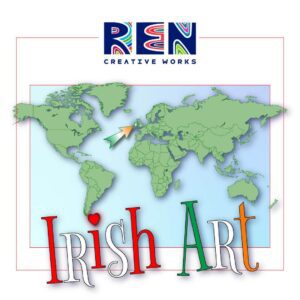
Conclusion: Embark on an Artistic Adventure in Ireland
I hope you enjoyed my blog on famous Irish art. I know you may have heard of some of these artists, but this was just a quick guide to introduce you to some of the most significant artists and artwork in the country and the cultural significance behind it.
There are many beautiful artworks in Ireland, created by both famous and lesser-known artists. From the fine arts to the decorative arts, all play a significant part in the cultural history of Ireland.
This article gave you the chance to learn a little bit more about these influential Irish artists, without requiring you to travel.
If you would like to learn more about how cultural identity affects other regions of the world, you should check out the main article on this topic, and by clicking on the links below:
- 10 ways cultural identity has influenced African Art
- 10 ways cultural identity has influenced Asian Art
- 10 ways cultural identity has influenced Caribbean Art
- 10 ways cultural identity has influenced European Art
- 10 ways cultural identity has influenced North America’s Art
- 10 ways cultural identity has influenced South America’s Art
- 10 ways cultural identity has influenced Oceania Art
I hope you get the opportunity to discover the wonderful variety of art that Ireland has to offer first-hand one day.
If you enjoyed this article, please subscribe to my mailing list and share it with your friends, family, and business associates if you think they would be interested. As an independent artist, this kind of support is invaluable.
The time you spent reading this blog is greatly appreciated, thank you.
Title: The Byerley Turk: The True Story of the First Thoroughbred
Author: Jeremy James
Publisher: Merlin Unwin Books; Reprint edition (12 Mar. 2007)
Language: English
Paperback: 368 pages
ISBN-10: 1873674988
ISBN-13 : 978-1873674987
The Battle of The 3 Legged Dog and Blue Blob v…..
This one-of-a-kind Acrylic Painting, shows you own something unique.
Adrian Reynolds, or ‘Ren,’ is a Dublin-based contemporary artist. His works are a reaction to the world around us. A world that continues to evolve quicker than ever. His work investigates colour, form, and texture, putting them at the intersection of abstraction and representation. His art has been shown in Ireland, the United Kingdom, and the United States.
Latest Artwork
-
Bullets Travel Distance & Time
Abstract Art Paintings €1,000.00Add to basketBullets Travel Distance & Time | Acrylic Painting By Adrian Reynolds
-
The Perception of Narrative
Abstract Art Paintings €800.00Add to basketThe Perception of Narrative | Fine Art Acrylic Painting By Adrian Reynolds
-
Iridescent Dream
Abstract Art Paintings €240.00Add to basketIridescent Dream | Acrylic Painting By Adrian Reynolds
-
Blue Nebula
Abstract Art Paintings €240.00Add to basketBlue Nebula | Acrylic Painting By Adrian Reynolds
